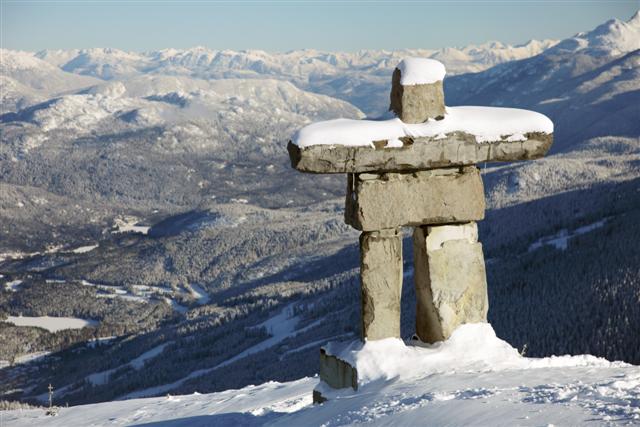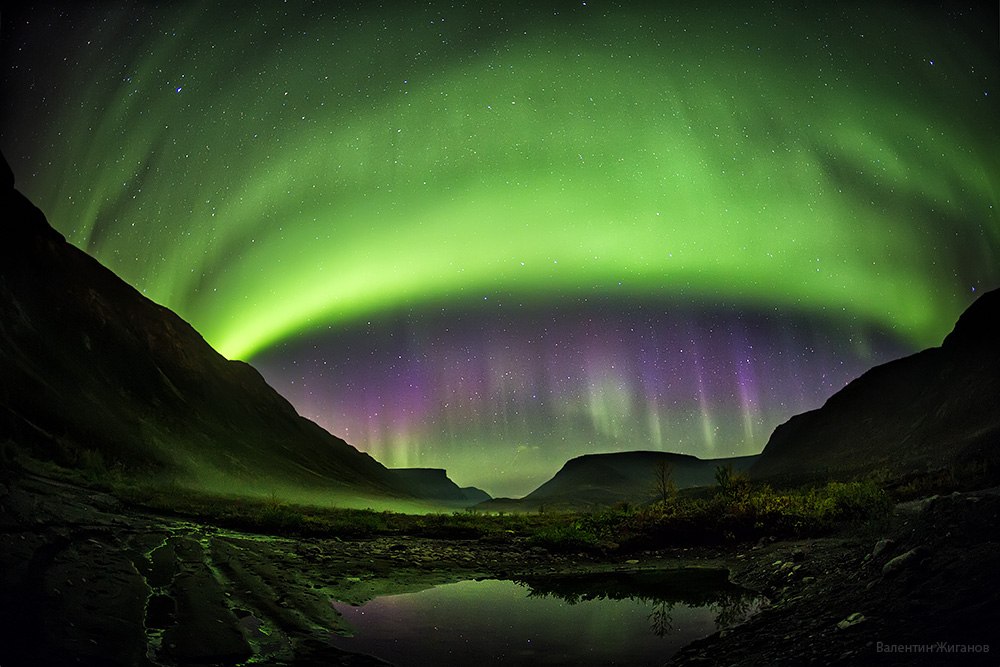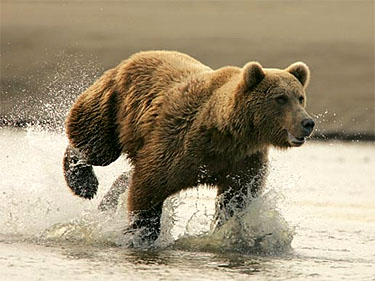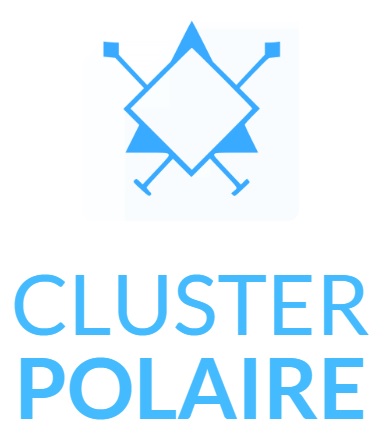Articles
 The Northern Region has many faces. Historically it has been veiled by an aura of mystique, a frozen wonderland untouched both by the outside and the effects of industrialization, populated by a mysterious group of people from a different phase in the history of man. As interesting and romantic this notion may seem, it holds little or no truth in the Arctic today.
The Northern Region has many faces. Historically it has been veiled by an aura of mystique, a frozen wonderland untouched both by the outside and the effects of industrialization, populated by a mysterious group of people from a different phase in the history of man. As interesting and romantic this notion may seem, it holds little or no truth in the Arctic today.
The Arctic is literally on top of the world, the earth rotating around the two poles, in the North and the South. But the Arctic is not just about the North Pole - the Arctic region stretches much further in all directions, even splitting the earth into the East and the West, famous identities in the world history.
Once a joke about vast wilderness where nobody ever went, the Arctic is becoming increasingly popular in many ways making the life of the 4 million people living in the region both scary and exiting at the same time.
Climate change is the one major denominator for the change in the region today. Because of its clear visibility in the Arctic, peoples eyes have moved north in recent years.
While the melting sea ice has led to problems for local people to practice their traditional livelihoods, it has also created unprecedented opportunities, including shipping in the Arctic. By sailing through the Arctic Ocean, the shipping route from Europe to Asia is significantly shorter and therefore very attractive for shipping companies.
In addition, enormous amounts of resources lie in the area, including oil and gas reserves that are extremely valuable. Resource exploitation has already begun, but the challenges are many when the area is so big and so far from any infrastructure.
The Arctic is thus both an industrial region, as well as a region in close connection to its history and culture. A mixture of traditional subsistence activities as well as a part of the global market economy. The new and the old submerge to strengthen each other with new technology and knowledge, contributing to a cultural rejuvenation occurring in the Arctic.
With more research and more interest from policy makers in the Arctic, they eyes of the media has also cantered further to the north. With more media attention the general public learns more and more about the Arctic.
But what exactly is in the Arctic? Who lives there? What animals live there? What is it all about? The Arctic Portlet seeks to answer all the general questions about this exciting area giving the readers an insightful peek into one of the world's last true wildernesses.
Learn about the Arctic from the Arctic Portlet.

The Northern Forum is a membership-based international organization. The name of the organization is International Organization of Northern Regions “The Northern Forum”. The short name is The Northern Forum, NF.
The Northern Forum was established on 8 November 1991 in Alaska, USA and the Northern Forum Non-Profit Organization Certificate was issued on 29 November 1991.
Currently, the Northern Forum has 12 member regions: Jewish Autonomous Okrug, Kamchatka Krai, Krasnoyarsk Krai, Magadan Oblast, Nenets Autonomous Okrug, Sakha Republic (Yakutia), Khabarovsk Krai, Khanty-Mansyisk Autonomous Okrug - Yugra, Chukotka Autonomous Okrug, Yamal-Nenets Autonomous Okrug, State of Alaska (USA), Gangwon Province (Republic of Korea), as well as 10 business partners from the Russian Federation, Iceland, Norway, USA, and Japan.
Chairing region: Khanty-Mansiysk Autonomous Okrug-Yugra, Russia.
The Northern Forum is an Observer of the Arctic Council, UN Framework of the Climate Change Convention and is accredited in UNEP. The Northern Forum has wide international partnership network.
Mission and Purposes
The mission of the Northern Forum is to improve the quality of life of Northern peoples and support sustainable development of the regions.
Purposes:
• to provide Northern regional leaders and representatives of the regions a means to share their knowledge and experience in addressing common challenges;
• to implement cooperative socio-economic initiatives among Northern regions;
• to organize international forums and implement projects.
Vision
Turning the Northern Forum into an effective, non-alternative structure for interregional international cooperation of the regions of the North and the Arctic, which shapes world politics in this area and is an equal partner of the Arctic Council, the Barents Region, the University of the Arctic, with its own unique niche.
- To become a global competence center for interregional international cooperation of the territories of the Arctic and the North.
- To become an effective training and educational organization for its members and partners.
- To become a platform for innovative projects.
- To become an efficient bridge between the entrepreneurs and development finance institutions.
- To become a smart organization through a partner and expert network.
Principles
- The principle of public (“grassroots”) diplomacy.
- The principle of independence and equality.
- The principle of non-discrimination.
- The principle of reliance on neighborhood effects and diversity effects.

The Northern Forum's activities are not limited to official meetings - from the very beginning, a variety of projects work under the auspices of the Northern Forum.
The projects are split into three programs: Environment, Sustainable Development and Society & Culture.
Please see the links for more information.
 The Northern Forum seeks to strengthen connections among all Northerners, particularly decision-makers. Membership is available to regional and sub-regional governments, municipalities (where there is no regional entity) businesses, non-profit and non-governmental organizations.
The Northern Forum seeks to strengthen connections among all Northerners, particularly decision-makers. Membership is available to regional and sub-regional governments, municipalities (where there is no regional entity) businesses, non-profit and non-governmental organizations.
Member regions are represented by their Governor, Premier, President or highest executive, or his/her duly mandated delegate, and have the right to attend all Northern Forum meetings and vote during such meetings.
Inter-regional activities are strongly supported by the Northern Forum as a tool to increase cooperation and understanding between regions. The friendships, links and connections created during the visits of delegations from one region to another are extremely important to build healthy international relations.
While the Northern Forum's activities are broadly based, the organization clearly recognizes that economic development is a key issue throughout the North. Thus, in addition to broadening its membership base among regional governments, the Northern Forum is actively seeking new members from the commercial sector, since sustainable Northern economic structures cannot be developed without the support of the business community. Consequently the Forum offers a range of business memberships, including those for associations such as Chambers of Commerce.
Business Partners are entitled attend all open Northern Forum meetings, where they can meet with regional government officials and other Northern Forum members to discuss business, trade and other challenges and opportunities. The Northern Forum's databases, publications, and other resources are also made available to members. Regional member officials will expedite the development of contacts with Northern Forum Business Partners on projects proposed within their regions. Business Partners can also use the office of the Northern Forum Secretariat when in Anchorage to conduct their business.
The First Northern Business Conference was held in 1999 in Rovaniemi, Finland in conjunction with the 4th Northern Forum General Assembly, and now the Northern Forum regularly hosts Trade and Business Summits during its meetings, so that all the regions are exposed to each other's business and trade potential. This initiative is giving significant results, with large contracts being signed between Northern Forum Business Partners and an increasing number of regions.
According to the Board of Governors decision upon the Northern Forum Resolution 163, the membership dues are as follows:
Approve the following gradation of the membership dues for the regions:
- For the regions with population less than 100,000 people: USD 5000 (Five thousand US Dollars)
- For the regions with population from 100,000 to 200,000 people: USD 9,000 (Nine thousand US Dollars)
- For the regions with population from 200,000 to 300,000 people: USD 13,000 (Thirteen thousand US Dollars)
- For the regions with population from 300,000 to 400,000 people: USD 17,000 (Seventeen thousand US Dollars)
- For the regions with population from 400,000 to 500,000 people: USD 21,000 (Twenty one thousand US Dollars)
- For the regions with population more than 500,000 people: USD 25,000 (Twenty five thousand US Dollars)
Approve the following gradation of the yearly membership dues for business partners:
- For the companies with less than 50 employees: USD 1,000 (One thousand US Dollars)
- For the companies with 51 to 100 employees: USD 2,500 (Two thousand five hundred US Dollars)
- For the companies with more than 100 employees: USD 5,000 (Five thousand US Dollars)
- For the companies acting as a Sponsoring partner: USD 10,000 (Ten thousand US Dollars) or more
Regions of the Northern Forum generally know about bears very well – contacts of humans and brown bears in settlements or near them are not rare. As this is a very dangerous neighborhood practice, the BBWG’s work is dedicated to researching and creating conditions where bears and humans can co-exist without interaction. As this is mostly an experience-exchange initiative, this is a great opportunity for beginner biologists and nature conservationists to apply their knowledge in practice and learn from the experienced ones.
This Working group consists of experts, scientists, regional administrations’ employees and even the whole organizations as well – good example of it is Swedish Orsa Gronklitt Predator Park zoo.
Project progress (2011-2013)
Meeting in Orsa Gronklitt Predator Park (Dalarna, Sweden) in August 2011 – 13 participants from 7 regions of 4 states. On this meeting, a working plan was discussed and participants exchanged experience on controlling predator populations (that is - wolves). Planned meeting in Khanty-Mansiysk was cancelled due to financial hardships.
2013 Working plan:
- Monthly e-mail communication to exchange ideas and updates on projects
- Continuation of work on gene analysis of the Far Eastern Brown Bear (Far East Russia)
- Grant sourcing work to broaden the scope of the project
- Consideration of holding a meeting in Orsa, Dalarna (Sweden) in December 2013
- Continuation of joint work with an IUCN expert group on Northern Asian Brown Bear (many of the project participants are also participants of the IUCN expert group)
picture courtesy: bearsoftheworld.net
The Business Forum working area includes .........
The effects of climate change in the Arctic constitute to both threats and opportunities for the Arctic communities. Arctic People experience changes in the nature. The living conditions are changing – some to the better and other living conditions are weakening the basis of traditional living in the Arctic. As an example, the build environment in form of houses and roads are threaten in areas where the permafrost is thawing.
Business Opportunities
New business opportunities in the sectors of energy extraction, shipping, fishing and tourism are being identified in the Arctic changes. Energy extraction and increased shipping activities because of sea ice retreat are in particular characterized as being capital intensive and involving risks to the environment. The potential environmental consequences of risk events such as an oil spill or ship accidents is significantly greater than in other regions, with implications for governments, businesses and the insurance industry. Responsible realization of the economic opportunities in the Arctic will therefore depend on strong regulatory frameworks and corporate environmental commitment.
Scientific data and business and communities
The business sector will play an important and central role in the sustainable development of the Arctic. For business sectors to prepare and manage their operation in environmentally responsible way, information on environmental changes and geological potentiality of the Arctic has to become accessible. Closing the knowledge gap by granting the businesses access to Arctic data will reduce the risk of severe environmental consequences and will constitute to ensuring that the increased activity in the Arctic takes place within sensible ecological limits. Businesses preparing and operating at large scale in the Arctic will benefit from having searchable access and analytical display of research documents, metadata together with qualitative and quantitative datasets on numerous topics across disciplines and themes covering the Arctic. The engagement of geographic information systems (GIS) compliant visualization and query technologies, will facilitate the conversion of data to information and permanent knowledge. Such an Arctic data and information square adapted to standard scientific information is not available yet. The Arctic data and information square would not only benefit the business sector preparing and operating in the Arctic. It would also benefit the regional and local authorities and communities to have searchable access of Arctic data on numerous topics across disciplines and themes to manage the risk of increased activities and identify new opportunities for the Arctic communities.
Information portal on Arctic societies
As the Arctic is having increased attention from businesses outside the region exploring new business opportunities within the Arctic, the need of disseminating information on Arctic societies becomes more urgent. The Arctic societies can benefit from the attention outside the region by promoting their societies towards defined target groups based on the interests of the Arctic societies. The utilization of internet portals makes is possible for the Arctic societies to promote their regions by providing extensive information service aimed at generating increased business activities in the Arctic and increasing cooperation between business and cultural entities within and outside the Arctic. Developing new business activities in the Arctic demands dissemination on various social information and general business information and statistics in order to inform outsiders about individual societies in the Arctic. Furthermore, the increasing business activities and business cooperation in the Arctic call for an easy access to practical information, e.g. how and when to reach and travel within certain regions and where to find companies within certain business segment together with contact information. Business, culture and travel are interconnected and the Arctic societies can promote their interests on these fields simultaneously.
|
1 |
Arctic Portal (Akureyri, Iceland)
|
Ráðhústorg 7 600 Akureyri Iceland Website: https://arcticportal.org Tel: +354 4612800 |
|
|
2 |
Institute of the North (Alaska, USA)
|
715 L Street, Suite 300 Anchorage, Alaska 99501 USA Website: https://institutenorth.org Tel: (907) 786-6324 Fax: (907) 786-6368 |
|
|
3 |
Arctic Business Relations LLC of Ukpeaġvik Iñupiat Corporation (UIC) (Alaska, USA)
|
Ukpeaġvik Iñupiat Corporation PO Box 890 Barrow, AK 99723 Website: https://uicalaska.com Tel: (907) 852-4460 Fax: (907) 852-4459 |
|
|
4 |
Energy Saving Technologies LLC (Sakha Republic (Yakutia), Russia)
|
677018, Russian Federation, Republic of Sakha (Yakutia), Yakutsk, Dejnev str., apt. 35/1 Website: https://www.ensatech.ru Tel: +7 (4112) 32-01-38 Fax: +7 (4112) 32-01-81 |
|
|
5 |
Lapland Chamber of Commerce (Finland)
|
Maakuntakatu 29-31B, FI-96200 Rovaniemi Website: www.lapland.chamber.fi |
|
|
6 |
French Polar Cluster (France)
|
17 Avenue de Madrid, 92200, Neuilly-sur-seine, France Nav. Loc.: 01.83.06.76.73 Website: http://www.clusterpolaire.fr |
|
|
7 |
High North Center for Business and Governance of the Business School at Nord University (Norway)
|
FRODE MELLEMVIK Professor Website: https://www.nord.no/no/om-oss/fakulteter-og-avdelinger/handelshogskolen/senter/nordomradesenteret Tel: +47 75 51 77 05 |
|
|
8 |
Hokkaido International Exchange and Cooperation Center (Japan)
|
Hokkaido International Exchange and Cooperation Center Hokkaido Government Annex Bldg. West 7, North 3, Chuo-ku, Sapporo, Hokkaido, Japan 060-0003 Website: http://www.hiecc.or.jp/english/foreign.html Tel: +81(11)221-7840 Fax: +81(11)221-7845 |
|
|
9 |
Alaska Native Heritage Center (Alaska, USA)
|
Alaska Native Heritage Center 8800 Heritage Center Drive Anchorage, Alaska 99504 e-mail: http://www.alaskanative.net/en/para-nav/contact-us/ Website: http://www.alaskanative.net/en/para-nav/home/ Tel: (907) 330-8000 Toll Free: (800) 315-6608 Fax: (907) 330-8030 |
|
|
10 |
Nord Power LLC (active recreation park Urdel) (Sakha Republic (Yakutia), Russia) |
677004, Russian Federation, Yakutsk, Urdel Park Street, 1 Tel: 7‒924‒177‒77‒65 |
|
|
11 |
JSCB Almazergienbank JSC (Sakha Republic (Yakutia), Russia) |
677000, Russian Federation, Yakutsk, Lenin Ave., 1 Tel: 7 (4112) 34-22-22 Website: https://www.albank.ru |
|
|
12 |
Teplorium LLC (Chuvash Republic, Russia) |
428903, Russian Federation, Cheboksary, Vurnarskoe highway, no. 10, room. 1 Tel: 7 (4112) 34-22-22 |
|
 Climate change is a forefront of concerns in the North and the Arctic, where its effects are more noticeable than in other parts of the planet and can impact very drastically the local populations.
Climate change is a forefront of concerns in the North and the Arctic, where its effects are more noticeable than in other parts of the planet and can impact very drastically the local populations.
See the latest Arctic report card by NOAA.
The Province of Quebec organized a Permafrost Degradation workshop in Quebec City, April 19 and 20, 2012, just after the Regional Coordinators' meeting to enable the regions to exchange experiences and know-how.
The Northern Forum's Flood Working Group, concerned with severe climate change impacts, has now become the Water and Climate Change Working Group, dealing not only with flooding but other aspects such as coastal erosion, wildfires, permafrost melting etc.
For more information on climate change, go to the Arctic Portal Portal on Climate Change.

The eight Arctic states work closely together on numerous Arctic-related issues, both through the Arctic Council and in various other forums.
Between the WW II and the late 20th century, the Arctic was one of the playgrounds of the cold war experiencing nuclear armament and frozen international relations. The cold war political environment left the area distant and remote for the people outside the region and it was not until the emergence of the perestroika in the Soviet Union which gradually brought the cold war enemies closer and eventually to the same table in 1989.
The first purely Arctic oriented meeting of the eight Arctic countries took place in Rovaniemi Finland in september 1989. The topic of the meeting was the fragile Arctic environment and a potential for joint effort in tackeling the very delicate but urgent issue. After intensive cooperation for the next two years, the Arctic Environmental Protection Strategy was initiated in 1991. The AEPS concentrated on cooperation in scientific research and sharing of data on effects of pollution as well as assessing the potential environmental impacts of development activities in the Arctic through its four specific measures, namely Arctic Monitoring and Assessment Programme, Protection of the Marine Environment in the Arctic, Emergency Prevention,Preparedness and Response in the Arctic and Conservation of Arctic Flora and Fauna.
The cooperation around the AEPS was quite untraditional for many reasons. First, it was one of the first venues where the cold war parties cooperated together to reach a common goal and secondly it became one of the very few inter-governmental institutions including indigenous peoples of the region in the work from the beginning.
It became, however, soon clear that the Arctic issues and the change happening in the Arctic environment would have such an immense impact globally that it was decided that the AEPS would step aside and new inter-governmental high level forum would be created to deal Arctic environmental issues. In 1996, the Arctic Council, with membership of all eight Arctic states and permanent participation of regional indigenous peoples' associations, was established to promote cooperation, coordination and interaction in issues of sustainable development and environmental protection.
Yet a new development on the Arctic cooperation occured in May 2011, when the Arctic states signed the first legally binding agreement established under the auspices of the Arctic Council. The Agreement on Cooperation on Aeronautical and Maritime Search and Rescue in the Arctic lays down a framework to strengthen search and rescue cooperation and coordination in the Arctic airspace and waters.
In addition to the official state-level cooperation taking place in the Arctic Council, two other cooperation themes in the Arctic have been indentified by the Arctic Human Develoment Report.
The first theme focuses on the increasing circumpolar cooperation by indigenous people's organizations and sub national governments, culminating in notion "North meets North." In facing harsh socio-economic realities and degradation of human rights the Indigenous peoples and local communities have realized the value of cross border cooperation in their battle for human rights and increased socio-economic development. Organizations such as RAIPON (Russian Association of Indigenous Peoples of the North) and the Saami Council have been working towards the international recognition of indigenous people's rights and the consideration of traditional livelihoods in national politics.
The second theme focuses on the relationship between the Arctic and the outside world. The first signs of interest in the Arctic from southern latitudes were during the Cold War, because of the military issues. But the amount of natural resources and potential trans-Arctic transportation routes make the region strategically and economically relevant for most European, North-American and North-East Asian countries. The economies of the North are closely related and the importance of the Arctic region will rise due to ever increasing demand for resources. Also globalization will keep bringing in new actors to the Arctic and cooperation continues to grow in various fields in the future.
For more information on a region of your interest, please use clickable region names below.
| Arctic Council states | Northern Forum Regions | |
| Canada | Akureyri (Iceland) | Murmanskaya Oblast (Russia) - Observer |
| Greenland | Chukotskiy AO(Russia) | |
| Finland | Gangwon-do (South Korea) | |
| Iceland | Kamchatskiy Kray (Russia) | |
| Norway | Khanty - Mansiyskiy AO (Russia) | |
| Russia | Sakha Republic (Yakutia) (Russia) | |
| Sweden | Yamalo-Nenetskiy AO (Russia) | |
| United States |











